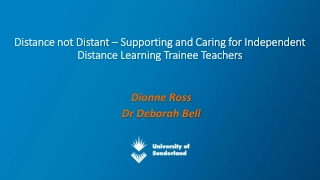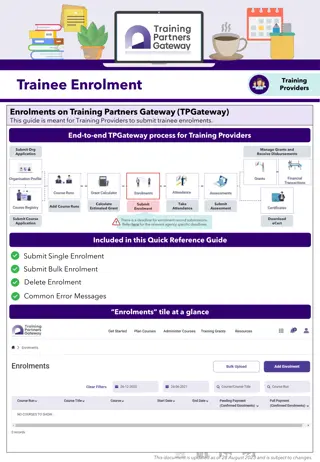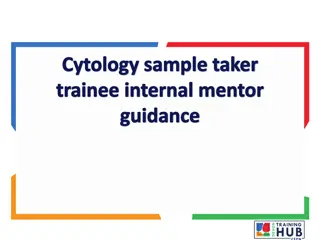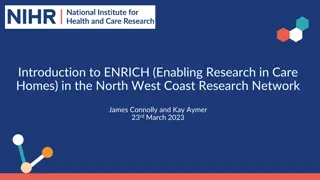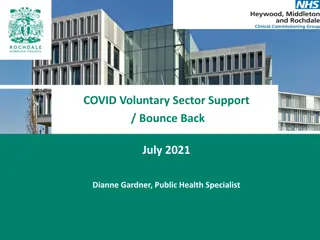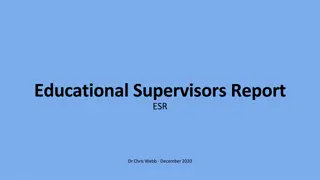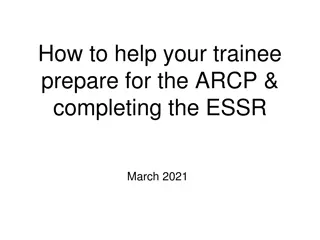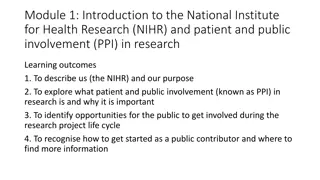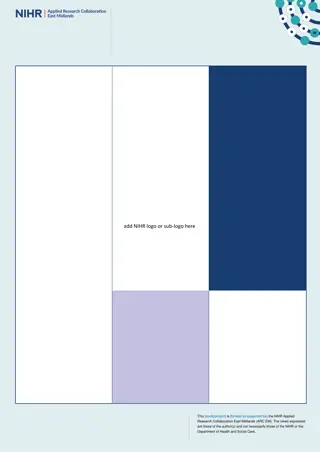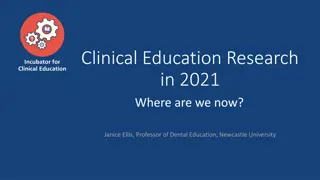CEV and the NIHR Trainee Research Network Overview
CEV, in collaboration with the NIHR Trainee Research Network, plays a key role in producing high-quality, independent systematic reviews to inform healthcare decisions. Explore the resources available for research assistance and learn how CEV fits within the NHS/NIHR research landscape and JLA priorities for setting research agendas.
Download Presentation

Please find below an Image/Link to download the presentation.
The content on the website is provided AS IS for your information and personal use only. It may not be sold, licensed, or shared on other websites without obtaining consent from the author.If you encounter any issues during the download, it is possible that the publisher has removed the file from their server.
You are allowed to download the files provided on this website for personal or commercial use, subject to the condition that they are used lawfully. All files are the property of their respective owners.
The content on the website is provided AS IS for your information and personal use only. It may not be sold, licensed, or shared on other websites without obtaining consent from the author.
E N D
Presentation Transcript
CEV and the NIHR trainee research network Miss Tasanee Braithwaite CEV Contact Editor Moorfields Eye Hospital, London On behalf of Richard Wormald, Iris Gordon and Anupa Shah
Overview Cochrane and CEV The NHS/NIHR research landscape and the JLA priorities: where does the CEV fit in? What is a Systematic review? What Cochrane resources are available to help you with your research?
The Cochrane Collaboration is a global independent network of health practitioners, researchers, patient advocates and others, responding to the challenge of making the vast amounts of evidence generated through research useful for informing healthcare decisions The Cochrane Collaboration produce high-quality, relevant, accessible systematic reviews and other synthesised research evidence, free from commercial sponsorship, prejudices and other conflicts of interest Internationally recognised as the benchmark for high quality information about the effectiveness of health care.
CEV UK Editorial Team Co-ordinating Editor (Editor in Chief): Richard Wormald Joint Co-ordinating Editor: Jenny Evans Managing Editor: Anupa Shah Information Specialist: Iris Gordon Contact Editors (Clinicians/healthcare professionals for different subspecialties)
Priority setting in the NHS the James Lind Alliance Funding for research is limited Target future research to answering the unanswered questions of greatest importance to patients, relatives, carers and eye care professionals Sight loss and vision priority setting partnership
Priority setting in the NHS the James Lind Alliance 122 research priorities 12 subjects ARMD, cataract, childhood-onset disorders, cornea/external eye disease, glaucoma, inherited retinal disease, neuro- ophthalmology, ocular cancer, ocular inflammatory diseases, refractive error and ocular motility, retinal vascular diseases, vitreoretinal and ocular trauma 10 to 11 in each subject
Priority setting in the NHS the James Lind Alliance 5 domains: Basic science mechanism of disease, develop novel therapies Population-based: risk factors for disease, risk modifiers for outcomes and prognosis Efficacy and safety of interventions Investigations diagnostic test accuracy, screening Impact and enablement
What is a systematic review? A systematic review attempts to collate all empirical evidence that fits pre-specified eligibility criteria to answer a specific research question. It uses explicit, systematic methods that are selected with a view to minimizing bias, thus providing reliable findings from which conclusions can be drawn and decisions made
Why do a systematic review? We are inundated with unmanageable amounts of information - systematic reviews enable us to keep up to date with research evidence Systematic reviews summarise the available evidence - aid clinical decision making and guideline development Methodologically rigorous - attempt to limit issues of bias in both the included trials and the review process
Why do a systematic review? Confirm or refute existence of a treatment uncertainty issues of harms as well as benefits Sometimes include studies with conflicting findings heterogeneity in studies Inform design of future research empty reviews show gaps in evidence base, often required to secure funding for new studies
Limitations of systematic reviews Usually only use randomised studies but come in for criticism for not using other types of studies Rubbish in, rubbish out problems with interpreting data Cochrane Reviews are getting more complex to do and to understand is this the right way to go? Empty reviews and review conclusions that state we need more research - where does that leave the review author and the reader?
Embarking on a systematic review Getting the question right is vital issues of relevance and priority Structure your question using the PICO format Who is your audience ensure outcome measures are relevant to clinicians, patients, policy makers and guideline developers Get a statistician on board Get an information specialist on board Register your systematic review on PROSPERO - http://www.crd.york.ac.uk/PROSPERO/
Use the PICO format to structure your research question Population: who - adults, communities, villages Intervention: what - medical, surgical, educational Comparison: with - dosage, placebo, sham Outcome: how - measurement of effects. Primary and secondary outcomes
The Cochrane Systematic Review Process title registration protocol preparation editorial and peer review of the protocol publication of the protocol systematic review preparation editorial and peer review of the systematic review publication of the systematic review updating the systematic review
Why is searching important? Systematic reviews differ from narrative reviews in that the aim is to find existing evidence on a given topic and synthesize the results. If studies are missed then a review may be misleading. If only studies with positive outcomes are included then the review may over estimate the effect of a treatment. Missed studies leads to publication bias
Constructing a search Boolean operators AND retrieves only documents that have all terms useful for narrowing sets OR retrieves documents that have any terms useful for synonyms NOT retrieves documents not in the other set useful for limiting searches
Information sources to search General medical databases: The Cochrane Library, MEDLINE, Embase Specialist databases: PsycINFO, AMED etc. Ongoing clinical trials registers both commercial and government Handsearch conference proceedings Citation searching ISI Web of Science: Science Citation Index Expanded & Conference Proceedings Citation Index-Science Reference lists of published articles
Dont forget to consider the Grey Literature Literature that is not published in books or journals Examples - Government reports, conference proceedings, dissertations Can be difficult to find search grey literature databases such as OpenGrey. Embase has recently started to include conference abstracts Alternative searching methods needed: search subject- specific websites eg RNIB, Sightsavers, Fight for Sight. Grey literature may not give you enough information for data extraction, so you will probably need to contact the authors the response rate from these requests is very low
And ongoing research Identify studies in progress or studies that have been completed and no data has been published Add to review and update when data become available Contact researchers of ongoing studies They may be willing to provide preliminary data Check the outcome measures in the original study protocol against subsequent published reports of the study If some outcome measures are missing this could be selection bias.
Why searching hard matters: publication bias Studies with statistically significant results are more likely: To be published To be published rapidly To be published in English language journals To be multiple publications To be cited by other authors
More on bias Random sequence generation Allocation concealment Masking (blinding) of participants and outcome assessors Incomplete outcome data i.e. loss to follow up and intention-to-treat analysis Selective reporting
CEV also conduct SRs of diagnostic test accuracy DTA reviews compare diagnostic tests ability to detect disease reference test versus index test DTA satellite based in Italy at the University of Florence lead by Prof Gianni Virgili DTA handbook available at http://srdta.cochrane.org/handbook-dta-reviews
Risk ratio The probability of the event in the exposed versus the non-exposed group A relative risk of 1 means there is no difference in risk between the two groups. An RR of < 1 means the event is less likely to occur in the experimental group than in the control group. An RR of > 1 means the event is more likely to occur in the experimental group than in the control group.
CEV Resources CEV webpage links to Roadmap: How to complete a systematic review Cochrane Handbook a comprehensive guide to conducting systematic reviews Methodological Expectations of Cochrane Intervention Reviews Cochrane Training website Free online course on Journal Peer Review Software for download RevMan (for preparing and maintaining Cochrane Reviews) GRADEpro (for creating Summary of Findings tables) Cochrane Library 60 Protocols, 140 Reviews
CEV Training Resources for Peer Review www.eyes.cochrane.org/free-online-course-journal-peer-review Course objectives. To understand 1. The available evidence regarding the effectiveness and utility of the peer review process 2. The purpose, process, and responsibilities in peer review from the perspective of the author, editor and peer reviewer 3. The different types of clinical research questions and appropriate designs for studying them 4. The strengths and limitations of the various study designs 5. Measures used to test association between exposures and outcomes 6. How to apply critical appraisal to manuscripts submitted for peer review 7. How to provide meaningful feedback to authors and editors that they can use to improve manuscript quality Oriented to ophthalmologists, optometrists and other vision practitioners 12 lectures
Cochrane Training www.training.cochrane.org 12 Online Learning Modules available to approved review authors Introduction to systematic reviews Writing a Cochrane protocol Searching for studies Collecting data Risk of bias Meta-analysis Types of data Heterogeneity Analysing data Interpreting results Health economics Writing abstracts and Plain Language Summaries
CEV and you? A COCHRANE REVIEW IS A SOLID PIECE OF RESEARCH WITH A SIGNIFICANT IMPACT FACTOR MANY COCHRANE REVIEWS HAVE BEEN WRITTEN BY OPHTHALMOLOGISTS IN TRAINING IF THE QUESTION MATTERS, A COCHRANE REVIEW IS A VALUABLE STEP TO SECURE FUNDING If something is worth doing, it is worth doing properly


